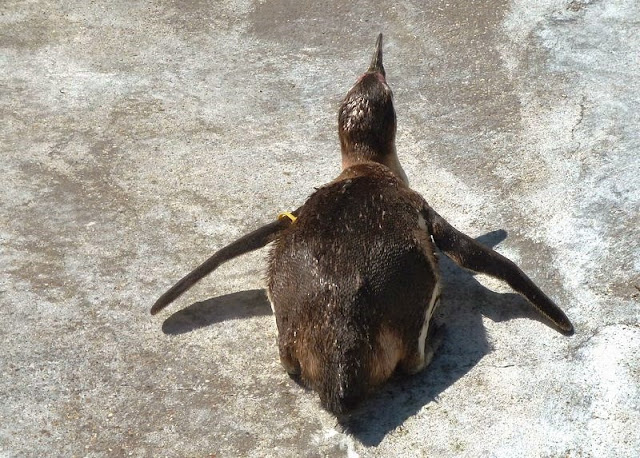
On this site once stood the Royal National Hospital for Diseases of the Chest, founded by Queen Victoria's physician, Dr Arthur Hill. With tuberculosis controlled by the coming of antibiotics, the hospital was demolished in 1969, but tales of ghosts haunting the site continue to this day.
Unfortunately there is still much work to be done as regards labelling of plants so my notes are restricted to my own limited knowledge. I think this large shrub is some kind of aster.
We come next to a small cascade surrounded by Zantedeschia or calla lilies, which enjoy damp shady conditions.
This area was generously planted with Osteospermum also known as Cape Daisies. Usually described as half-hardy they thrive in the hot dry microclimate of the Ventnor Undercliff which rarely sees frost and they flower here almost throughout the year.
Next is the Australian Garden with its Eucalyptus, Bottle Brushes and Tea Trees.
In the centre of the gardens is the Palm Garden, one of the few areas to survive from the hospital. The centrepiece is a group of Chusan Palms, or Trachycarpus fortunei which were presented to Queen Victoria, the oldest palms in the country and tough enough to survive even the Great Storm of 1987. The sub-tropical style is enhanced with rings of agapanthus.
Adjacent is the New Zealand Garden, an open lawn backed by dense shrubs, including Hebe, Olearia and Phormium, which grow well because of the humidity from frequent sea-mists. In summer, the garden is transformed into an outdoor theatre for Shakespearean performances.
In the centre is the café and a fish pond, home to koi carp and a rare giant Amazonian water-lily.
Around the terrace are these purple allium globes, part of the onion/garlic family.


Towards the coastal path, ornamental lawns dotted with rare species of trees stretch uphill.
 In the middle can be seen a tunnel behind a grill, usually closed. Its story is told on a sign; tramlines in the tunnel were used to transport rubbish from the hospital to be dumped in the sea. Occasionally open for tours, the tunnel leads out onto a small ledge in the middle of the cliff.
In the middle can be seen a tunnel behind a grill, usually closed. Its story is told on a sign; tramlines in the tunnel were used to transport rubbish from the hospital to be dumped in the sea. Occasionally open for tours, the tunnel leads out onto a small ledge in the middle of the cliff.Alongside the lawns runs a mixed border; today irises caught my eye.
 Heading back through the South African Terrace, this Carpobrotus edulis cascades down the rocky slope; also known as Hottentot Fig the yellow flower is less common but pink succulants can be seen streaming down the cliffs all over Ventnor.
Heading back through the South African Terrace, this Carpobrotus edulis cascades down the rocky slope; also known as Hottentot Fig the yellow flower is less common but pink succulants can be seen streaming down the cliffs all over Ventnor.Another frost-tender succulent that grows well in the area is this Lampranthus, covered in pink daisy like flowers.
Clumps of chives were in full flower in the herb garden.
The path leads back up to the entrance and car park, where more daisies made a splash of colour.
Bus 6 from Ventnor and Newport
Refreshments and WC in the garden cafe/shop area
































































